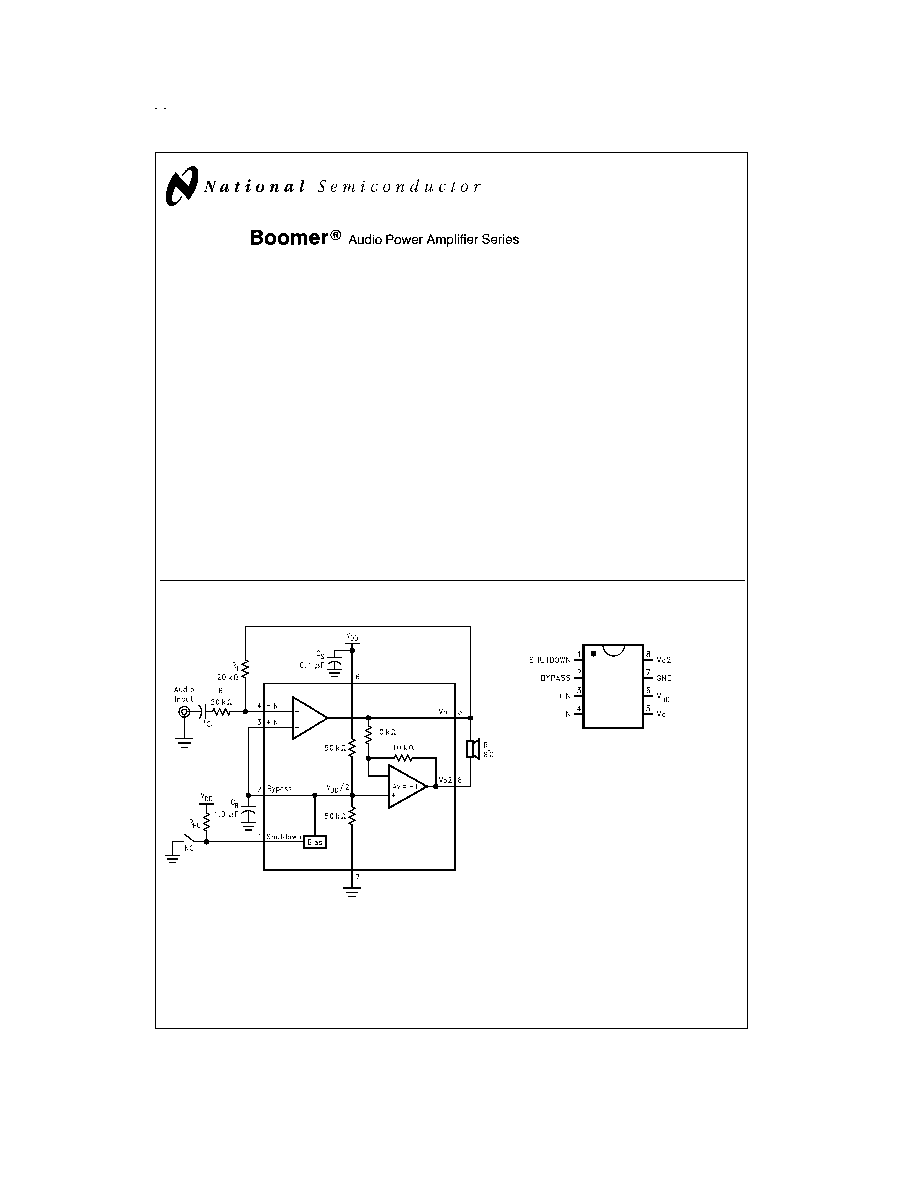
LM4862
675 mW Audio Power Amplifier with Shutdown Mode
General Description
The LM4862 is a bridge-connected audio power amplifier ca-
pable of delivering typically 675 mW of continuous average
power to an 8
load with 1% (THD) from a 5V power supply.
Boomer audio power amplifiers were designed specifically to
provide high quality output power with a minimal amount of
external components. Since the LM4862 does not require
output coupling capacitors, bootstrap capacitors, or snubber
networks, it is optimally suited for low-power portable sys-
tems.
The LM4862 features an externally controlled, low-power
consumption shutdown mode, as well as an internal thermal
shutdown protection mechanism.
The unity-gain stable LM4862 can be configured by external
gain-setting resistors.
Key Specifications
n
THD at 500 mW continuous average
output power at 1 kHz into 8
1% (max)
n
Output power at 10% THD+N at
1 kHz into 8
825 mW (typ)
n
Shutdown Current
0.7 �A (typ)
Features
n
No output coupling capacitors, bootstrap capacitors or
snubber circuits are necessary
n
Small Outline or DIP packaging
n
Unity-gain stable
n
External gain configuration capability
n
Pin compatible with LM4861
Applications
n
Portable Computers
n
Cellular Phones
n
Toys and Games
Typical Application
Connection Diagram
Boomer
�
is a registered trademark of National Semiconductor Corporation.
DS012342-1
*Refer to the Application Information section for information
concerning proper selection of the input coupling capacitor.
FIGURE 1. Typical Audio Amplifier Application Circuit
Small Outline and DIP Package
DS012342-2
Top View
Order Number LM4862M, LM4862N
See NS Package Number M08A or N08E
May 1997
LM4862
675
mW
Audio
Power
Amplifier
with
Shutdown
Mode
� 1999 National Semiconductor Corporation
DS012342
www.national.com
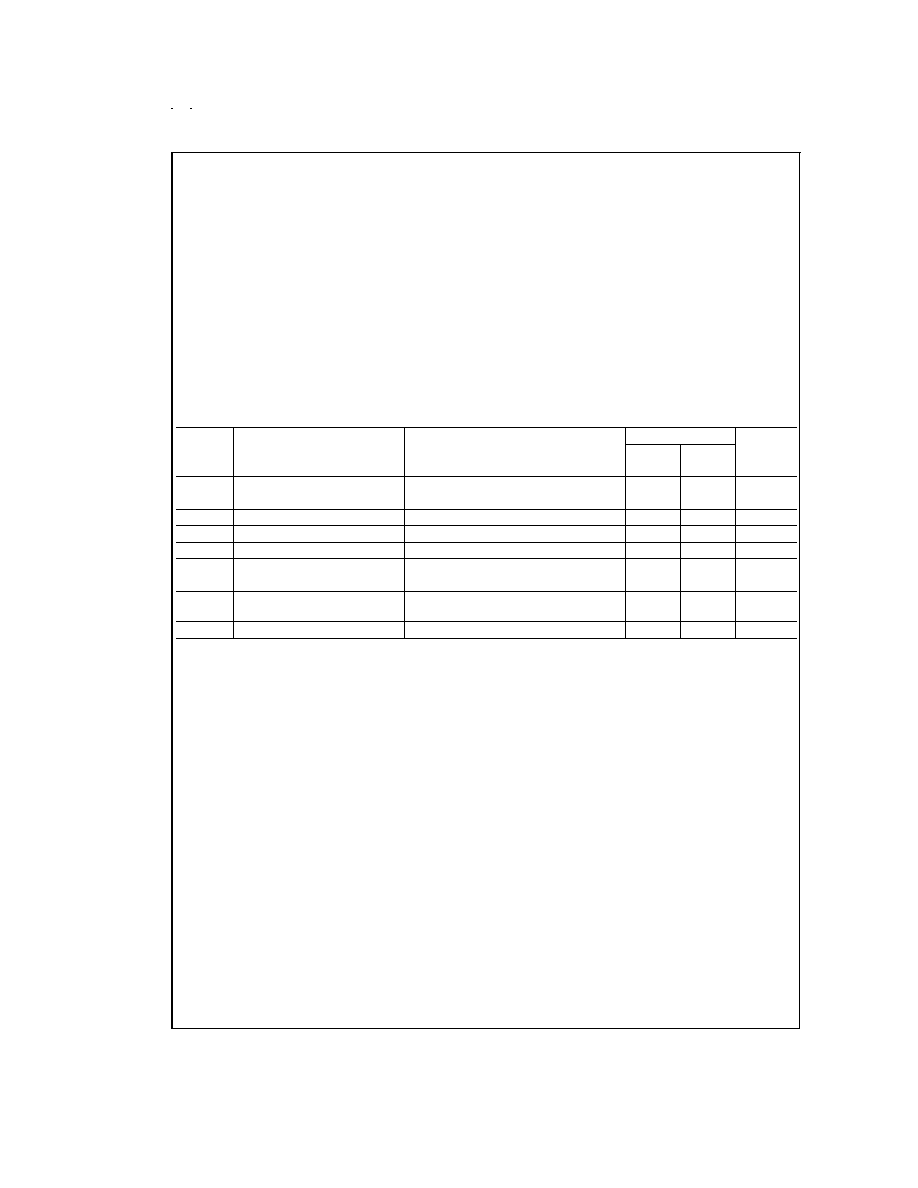
Absolute Maximum Ratings
(Note 2)
If Military/Aerospace specified devices are required,
please contact the National Semiconductor Sales Office/
Distributors for availability and specifications.
Supply Voltage
6.0V
Storage Temperature
-65�C to +150�C
Input Voltage
-0.3V to V
DD
+ 0.3V
Power Dissipation (Note 3)
Internally limited
ESD Susceptibility (Note 4)
3500V
ESD Susceptibility (Note 5)
250V
Junction Temperature
150�C
Soldering Information
Small Outline Package
Vapor Phase (60 sec.)
215�C
Infrared (15 sec.)
220�C
See AN-450 "Surface Mounting and their Effects on
Product Reliability" for other methods of soldering surface
mount devices.
Thermal Resistance
JC
(typ) -- M08A
35�C/W
JA
(typ) -- M08A
170�C/W
JC
(typ) -- N08E
37�C/W
JA
(typ) -- N08E
107�C/W
Operating Ratings
Temperature Range
T
MIN
T
A
T
MAX
-40�C
T
A
85�C
Supply Voltage
2.7V
V
DD
5.5V
Electrical Characteristics
(Note 1) (Note 2)
The following specifications apply for V
DD
= 5V unless otherwise specified. Limits apply for T
A
= 25�C.
Symbol
Parameter
Conditions
LM4862
Units
(Limits)
Typical
Limit
(Note 6)
(Note 7)
V
DD
Supply Voltage
2.7
V (min)
5.5
V (max)
I
DD
Quiescent Power Supply Current
V
IN
= 0V, I
O
= 0A (Note 8)
3.6
6.0
mA (max)
I
SD
Shutdown Current
V
PIN1
= V
DD
0.7
5
�A (max)
V
OS
Output Offset Voltage
V
IN
= 0V
5
50
mV (max)
P
O
Output Power
THD = 1% (max); f = 1 kHz; R
L
= 8
675
500
mW (min)
THD + N = 10%; f = 1 kHz; R
L
= 8
825
mW
THD + N
Total Harmonic Distortion +
Noise
P
O
= 500 mWrms; R
L
= 8
A
VD
= 2; 20 Hz
f
20 kHz
0.55
%
PSRR
Power Supply Rejection Ratio
V
DD
= 4.9V to 5.1V
50
dB
Note 1: All voltages are measured with respect to the ground pin, unless otherwise specified.
Note 2: Absolute Maximum Ratings indicate limits beyond which damage to the device may occur. Operating Ratings indicate conditions for which the device is func-
tional, but do not guarantee specific performance limits. Electrical Characteristics state DC and AC electrical specifications under particular test conditions which guar-
antee specific performance limits. This assumes that the device is within the Operating Ratings. Specifications are not guaranteed for parameters where no limit is
given, however, the typical value is a good indication of device performance.
Note 3: The maximum power dissipation must be derated at elevated temperatures and is dictated by T
JMAX
,
JA
, and the ambient temperature T
A
. The maximum
allowable power dissipation is P
DMAX
= (T
MAX
- T
A
)/
JA
. For the LM4862, T
JMAX
= 150�C. The typical junction-to-ambient thermal resistance, when board mounted,
is 170�C/W for package number M08A and is 107�C/W for package number N08E.
Note 4: Human body model, 100 pF discharged through a 1.5 k
resistor.
Note 5: Machine Model, 200 pF�240 pF discharged through all pins.
Note 6: Typicals are measured at 25�C and represent the parametric norm.
Note 7: Limits are guaranteed to National's AOQL (Average Outgoing Quality Level).
Note 8: The quiescent power supply current depends on the offset voltage when a practical load is connected to the amplifier.
www.national.com
2
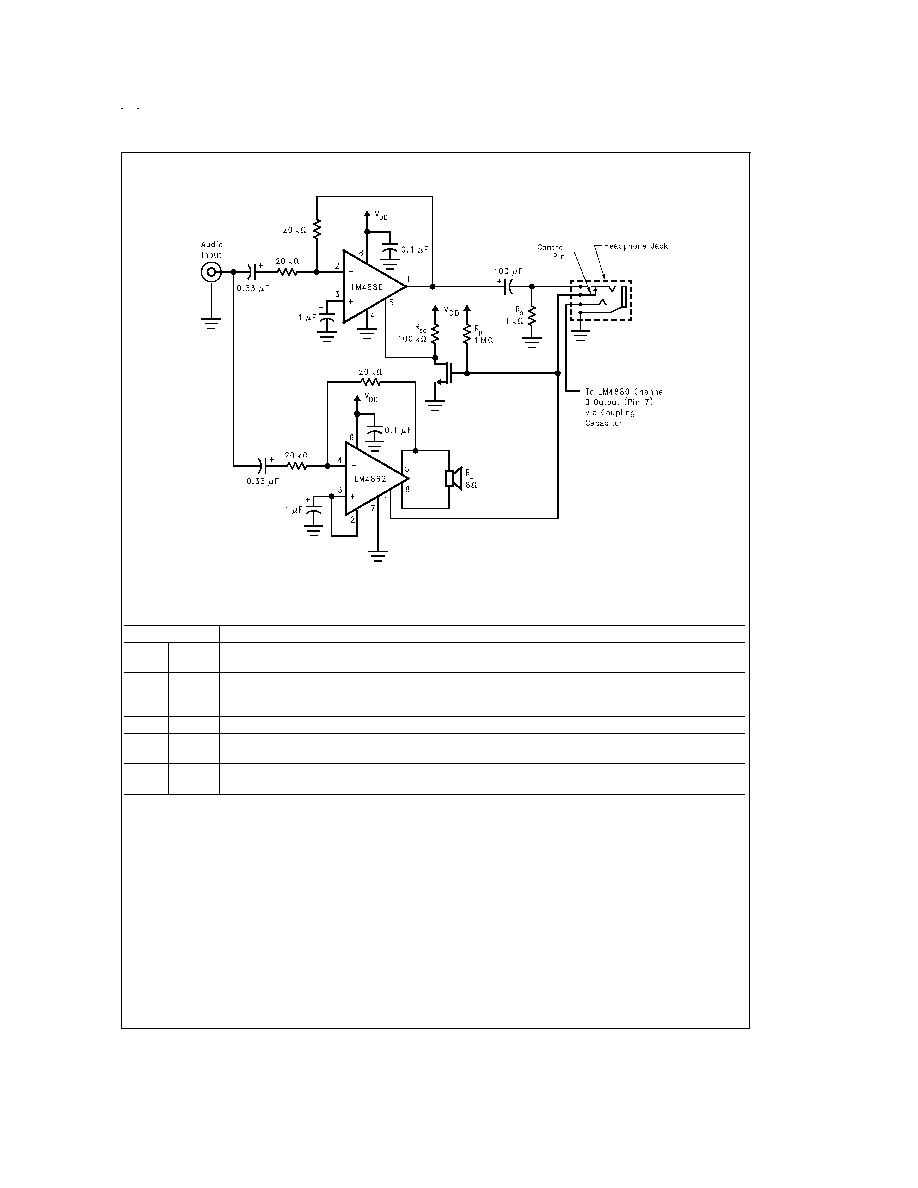
Automatic Switching Circuit
External Components Description
(
Figure 1)
Components
Functional Description
1.
R
i
Inverting input resistance which sets the closed-loop gain in conjunction with R
f
. This resistor also forms a
high pass filter with C
i
at f
c
= 1/(2
R
i
C
I
).
2.
C
i
Input coupling capacitor which blocks the DC voltage at the amplifier's input terminals. Also creates a
highpass filter with R
i
at f
c
= 1/(2
R
i
C
i
). Refer to the section, Proper Selection of External Components,
for an explanation of how to determine the value of C
i
.
3.
R
F
Feedback resistance which sets the closed-loop gain in conjunction with R
i
.
4.
C
S
Supply bypass capacitor which provides power supply filtering. Refer to the Power Supply Bypassing
section for proper placement and selection of the supply bypass capacitor.
5.
C
B
Bypass pin capacitor which provides half-supply filtering. Refer to the Proper Selection of External
Components section for proper placement and selection of the half-supply bypass capacitor.
DS012342-21
FIGURE 2. Automatic Switching Circuit
www.national.com
3
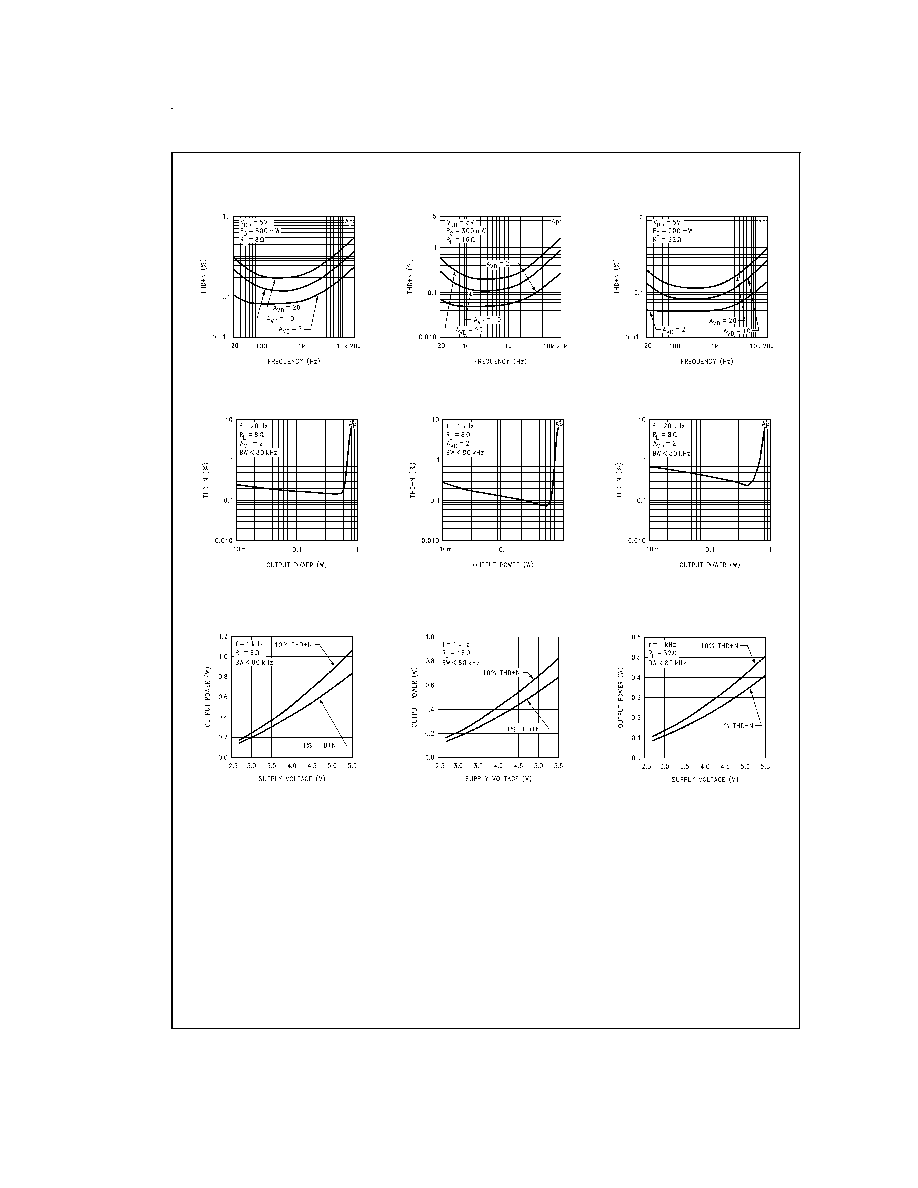
Typical Performance Characteristics
THD+N vs Frequency
DS012342-3
THD+N vs Frequency
DS012342-4
THD+N vs Frequency
DS012342-5
THD+N vs Output Power
DS012342-6
THD+N vs Output Power
DS012342-7
THD+N vs Output Power
DS012342-8
Output Power vs
Supply Voltage
DS012342-9
Output Power vs
Supply Voltage
DS012342-10
Output Power vs
Supply Voltage
DS012342-11
www.national.com
4
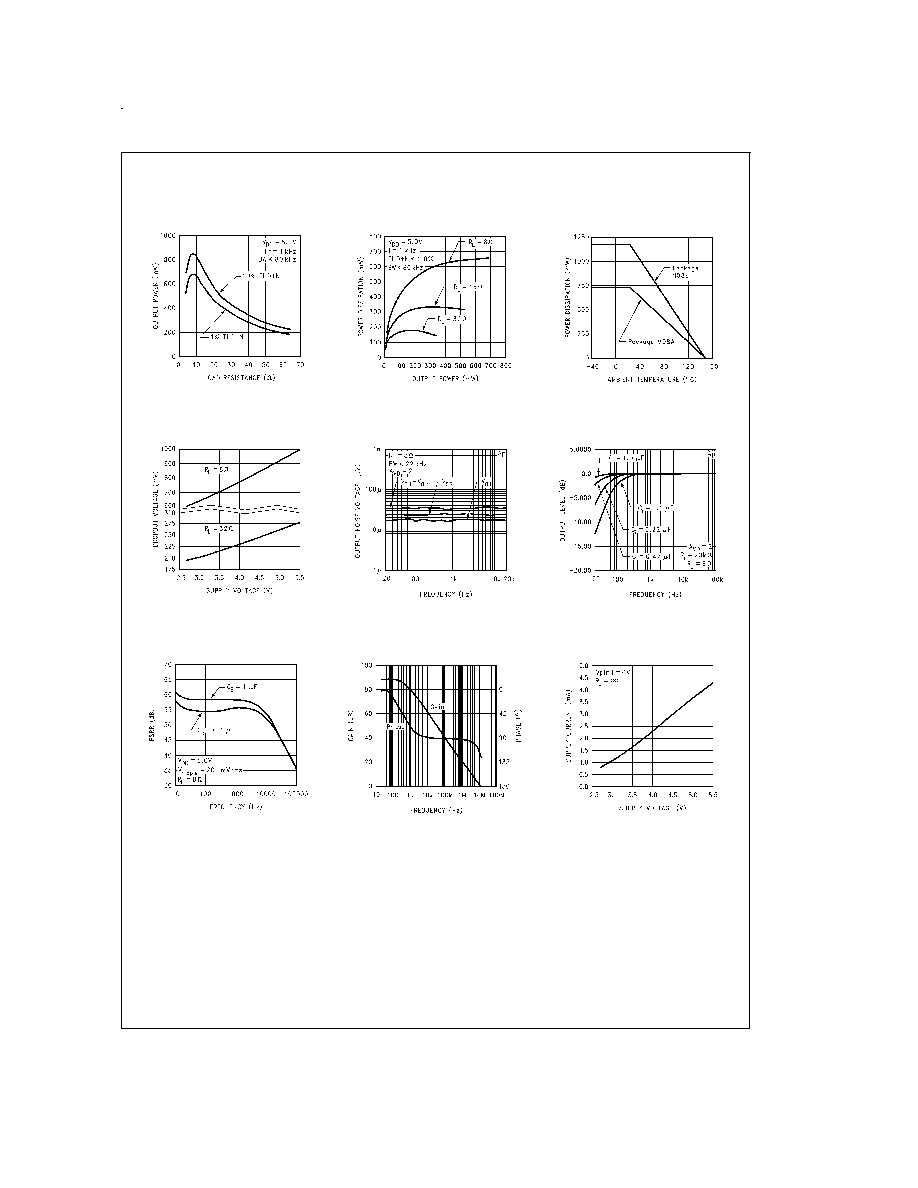
Typical Performance Characteristics
(Continued)
Output Power vs
Load Resistance
DS012342-12
Power Dissipation vs
Output Power
DS012342-13
Power Derating Curve
DS012342-14
Dropout Voltage vs
Power Supply
DS012342-15
Noise Floor
DS012342-16
Frequency Response vs
Input Capacitor Size
DS012342-17
Power Supply
Rejection Ratio
DS012342-18
Open Loop
Frequency Response
DS012342-19
Supply Current vs
Supply Voltage
DS012342-20
www.national.com
5




